cooling DODGE JOURNEY 2012 1.G User Guide
[x] Cancel search | Manufacturer: DODGE, Model Year: 2012, Model line: JOURNEY, Model: DODGE JOURNEY 2012 1.GPages: 108, PDF Size: 3 MB
Page 71 of 108

• Your vehicle has also been equipped with a TPMS malfunction indicator to indicatewhen the system is not operating properly. The TPMS malfunction indicator is
combined with the low tire pressure telltale. When the system detects a
malfunction, the telltale will flash for approximately one minute and then remain
continuously illuminated. This sequence will continue each time the vehicle is
restarted as long as the malfunction exists.
• When the malfunction indicator is illuminated, the system may not be able to detect or signal low tire pressure as intended. TPMS malfunctions may occur for a
variety of reasons, including the installation of replacement or alternate tires or
wheels on the vehicle that prevent the TPMS from functioning properly. Always
check the TPMS malfunction telltale after replacing one or more tires or wheels on
your vehicle, to ensure that the replacement or alternate tires and wheels allow the
TPMS to continue to function properly.
NOTE: Tire pressures change by approximately 1 psi (7 kPa) per 12° F (7° C) of air
temperature change. Keep this in mind when checking tire pressure inside a garage,
especially in the Winter. Example: If garage temperature is 68°F (20°C) and the outside
temperature is 32°F (0°C), then the cold tire inflation pressure should be increased by
3 psi (21 kPa), which equals 1 psi (7 kPa) for every 12°F (7°C) for this outside
temperature condition.
CAUTION!
The TPMS has been optimized for the original equipment tires and wheels.
TPMS pressures and warning have been established for the tire size equipped
on your vehicle. Undesirable system operation or sensor damage may result
when using replacement equipment that is not of the same size, type, and/or
style. Aftermarket wheels can cause sensor damage. Do not use tire sealant
from a can, or balance beads if your vehicle is equipped with a TPMS, as
damage to the sensors may result.
- Engine Temperature Warning Light
• This light warns of an overheated engine condition.
• If the light turns on and a warning chime sounds while driving, safely pull over and stop the vehicle. If the A/C system is on, turn it off. Also, shift the transmission
into NEUTRAL and idle the vehicle. If the temperature reading does not return to
normal, turn the engine off immediately.
• We recommend that you do not operate the vehicle or engine damage will occur. Have the vehicle serviced immediately.
WARNING!
A hot engine cooling system is dangerous. You or others could be badly burned
by steam or boiling coolant. You may want to call an authorized service center
for service if your vehicle overheats.
WHAT TO DO IN EMERGENCIES
69
Page 74 of 108

IF YOUR ENGINE OVERHEATS
• In any of the following situations, you can reduce the potential for overheating bytaking the appropriate action.
• On the highways — slow down.
• In city traffic — while stopped, place the transmission in NEUTRAL, but do not increase engine idle speed.
NOTE: There are steps that you can take to slow down an impending overheat
condition:
• If your air conditioner (A/C) is on, turn it off. The A/C system adds heat to the engine cooling system and turning the A/C off can help remove this heat.
• You can also turn the temperature control to maximum heat, the mode control to floor and the blower control to high. This allows the heater core to act as a
supplement to the radiator and aids in removing heat from the engine cooling
system.
CAUTION!
Driving with a hot cooling system could damage your vehicle. If the temperature
gauge reads 240°F (116 °C) or greater pull over and stop the vehicle. Idle the
vehicle with the air conditioner turned off until the pointer drops back into the
normal range 200–230°F (93–110°C). If the pointer remains at 240°F (116°C)
or greater and you hear a chime, turn the engine off immediately and call for
service.
WARNING!
You or others can be badly burned by hot engine coolant (antifreeze) or steam
from your radiator. If you see or hear steam coming from under the hood, do not
open the hood until the radiator has had time to cool. Never try to open a
cooling system pressure cap when the radiator or coolant bottle is hot.
WHAT TO DO IN EMERGENCIES
72
Page 84 of 108

WARNING!
• When temperatures are below the freezing point, electrolyte in a dischargedbattery may freeze. Do not attempt jump-starting because the battery could
rupture or explode and cause personal injury. Battery temperature must be
brought above the freezing point before attempting a jump-start.
• Take care to avoid the radiator cooling fan whenever the hood is raised. It can start anytime the ignition switch is on. You can be injured by moving fan
blades.
• Remove any metal jewelry, such as watch bands or bracelets, that might make an inadvertent electrical contact. You could be severely injured.
• Batteries contain sulfuric acid that can burn your skin or eyes and generate hydrogen gas which is flammable and explosive. Keep open flames or sparks
away from the battery.
• Do not allow vehicles to touch each other as this could establish a ground connection and personal injury could result.
• Failure to follow this procedure could result in personal injury or property damage due to battery explosion.
• Do not connect the cable to the negative post (-)of the discharged battery.
The resulting electrical spark could cause the battery to explode and could
result in personal injury.
SHIFT LEVER OVERRIDE
• If a malfunction occurs and the shift lever cannot be moved out of the PARK position, you can use the following procedure to temporarily move the shift lever:
• To access the shift lever override, remove the cubby bin liner located in the center console behind the shift lever. The override access port is at the front of the
cubby bin.
• Firmly set the parking brake.
• Turn the ignition switch to the ACC or ON position without starting the engine.
• Press and maintain firm pressure on the brake pedal.
• Using a screwdriver or similar tool, press and hold the override tab through the access port on the center console.
• Move the shift lever into the NEUTRAL position.
• The vehicle may then be started in NEUTRAL.
• Reinstall the override cover.
WHAT TO DO IN EMERGENCIES
82
Page 103 of 108

Air Conditioning............ 28
Airbag .................. 13
Alarm,Panic ............... 8
Arming Theft System
(Security Alarm) ............ 12
Audio Settings ........... 37,39
Automatic Headlights ......... 26
Automatic Temperature Control
(ATC) ................... 28
Automatic Transmission FluidType .............. 89
Auxiliary Audio/Video Input Jacks . . 59
AxleFluid ................ 89
Back-Up Camera ............ 31
Belts, Seat ............... 12
Booster Seat .............. 14
Brake Fluid ............... 89
Break-In Recommendations,
NewVehicle ............... 25
BulbReplacement ........... 97
Calibration,Compass ......... 60
ChangeOilIndicator .......... 71
ChangingAFlatTire .......... 73
Child Booster Seat ........... 14
Child Restraint ............. 14
Child Restraint Tether Anchors .... 15
Climate Control ............. 28
Clock Setting ............ 37,39
Compass Calibration .......... 60
Cooling System Coolant Capacity ........... 89
Cruise Control (Speed Control) .... 27
CruiseLight ............... 27
Customer Assistance .......... 98
Customer Programmable Features . . 61
Defects, Reporting ........... 99
Dimmer Control ............. 26
Dimmer Switch, Headlight ...... 26
Disarming, Theft System ....... 12
E-85Fuel ................ 90
Electronic Speed Control
(Cruise Control) ............. 27 Electronic Vehicle Information Center
(EVIC) ................ 60,61
Electronics
Your Vehicle's Sound System .... 34
Emergency Key .............. 8
Emergency, In Case of Freeing Vehicle When Stuck .... 84
Jacking ................ 73
Overheating ............. 72
Engine Break-In Recommendations .... 25
Compartment ............. 87
Oil Selection ............. 89
Overheating ............. 72
Starting ................ 10
Stopping ............... 10
Event Data Recorder .......... 85
Exterior Lights ............. 97
Flexible Fuel Vehicles ......... 90
Fluid Capacities ............ 89
Fluids .................. 89
FogLights ................ 26
Folding Front Passenger Seat ..... 18
FoldingRearSeat ........... 20
Freeing A Stuck Vehicle ........ 84
Front Heated Seats ........... 22
Fuel Specifications ............ 89
Fuses .................. 93
Garage Door Opener (HomeLink
®)..62
Headlights ............... 26
Automatic .............. 26
Dimmer Switch ........... 26
Heated Mirrors ............. 30
Heated Seats .............. 22
HomeLink
®(Garage Door Opener)
Transmitter ............... 62
Hood Release .............. 86
Instrument Cluster ............ 6
Indicators ............... 7
Instrument Cluster Warning
Lights ................. 6,68
Interior Fuses .............. 93
INDEX
101